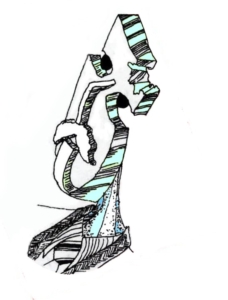VOWELS
Vowels (The Attractor Model)
Here, we try to give the attractor model of vowels in Türki which used to govern the so-called word formation in earlier eras of language. At that time any phenomenon used to be reported or refered to as an event via this attractor model.
The significance of vowels!
Each vowel sound, in its morphemic usage in Türki, is of very determining signification. This signification, no doubt, had functioned conceptually as a vector in early meaning. To understand this functional role, we would have to check and study the built-up topology of vowels as a system. It means that vowels do not function as mere sounds as grammar tries to put today. Vowels form some topology based on the immediate concepts formed in mind, or rather, based on the conceptual reflection of the reality. This system is fully relative to some starting reference concept called “dir”.
1. Dir (the unit of “existence/essence/entity”, in Arabic: وجود [vojud])
Everything with vowels starts from this essential concept of ‘dir’! ‘Dir’ is the starting point in this regard. It functions as the reference point cognitively.
Here, we can suppose ‘dir’ as either form below:![]()
Then, there is the space which is actually within reach (2. həndəvər).
2. Həndəvər (the environment actually in reach)
We can suppose ‘həndəvər’ as either form below (the space/environment actually in reach):![]()
Then, it is the whole surrounding environment (3. çevrə).
3. Çevrə /chevrə/ (the surrounding environment)![]()
Now we can see the conceptual formation of the topology which justifies the relative function of the vowel sounds (below):
![]() Now here, we check the topological system with the vowel sounds:
Now here, we check the topological system with the vowel sounds:
1. dir [ö] [ü]
According to the conceptual sdudies and annalysis of the vowel sounds [ö] and [ü] in Türki, these sounds are specifically related and have got coplementary role to each other. Here, we can see the significations of these two vowels:
ö: signifies: depth/core of ‘dir’
ü: signifies: surface of ‘dir’
We can check the topological positions of these dual vowels on the model of ‘dir’ according to the concepts these sounds signify, as follows:![]()
2. Həndəvər [ə] [e]
According to the conceptual sdudies and annalysis of the vowel sounds [ə] and [e] in Türki, these sounds are specifically related and have got coplementary role to each other. Here, we can see the significations of these two vowels:
ə: signifies: upper ‘həndəvər’
e: signifies: lower ‘həndəvər’
Here, we can see the topological positions of two vowels:![]() 3. Çevrə /chevrə/: [o] [u]
3. Çevrə /chevrə/: [o] [u]
According to the conceptual sdudies and annalysis of the vowel sounds [o] and [u] in Türki, these sounds are specifically related and have got coplementary functions to each other. In fact, these two complementary vowels, i.e, o and u are repeated forms or iterated forms of ö and ü in greater level. Here, we can see the significations of these two vowels:
o: signifies: near ‘çevrə’ (near environment)
u: signifies: far ‘çevrə’ (far environment)
Here, we can see the topologic positions of two vowels:![]()
‘Çevrə’, in fact, is the repetition of ‘dir’: [ö, ü] → [o, u]. Seemingly, it means that early man has considered the surrounding environment as more complicated and greater form of ‘dir’.
Now, we can make the following model out of the system of four vowels, as follows:![]()
4. up/down: [a] [ı]
According to the conceptual sdudies and annalysis of the vowel sounds [a] and [ı] in Türki, these sounds are specifically related and have got coplementary functions to each other.
Here, we can see the significations of these two vowels:
a: signifies: up, high, height, sky
ı: signifies: down, low, under ground
Here, we can see the topologic positions of two vowels:![]()
Now, we can make the following model out of the system of four vowels, as follows:![]()
5. in: [i]
According to the conceptual sdudies and annalysis of the vowel sound [i] in Türki, this sound indicates the inside of something.
Here, we can see the significations of this vowel:
i: signifies: in, inside
Here, we can see the topologic position of this vowel:![]()
The Attractor Model
The following model is the attactor model of the vowel sounds in Türki. Any structural formation of intended concepts or meanings have been due to this attractor model which detemines the tensors to express any phenomenon as an event:![]()
Therefore, each vowel sound will be checked and considered here from signifying point of view as follows:
- [] scalar concept (as a phoneme) …
- [–] vectorial concept (as a morpheme) relative to …
- (material-formally) …
